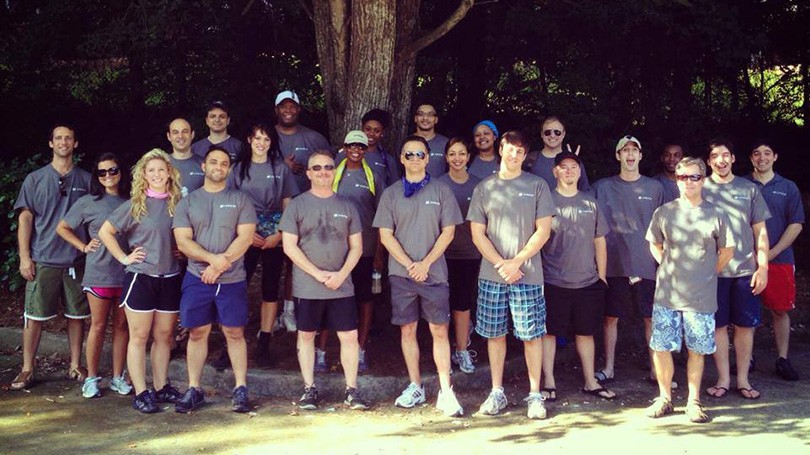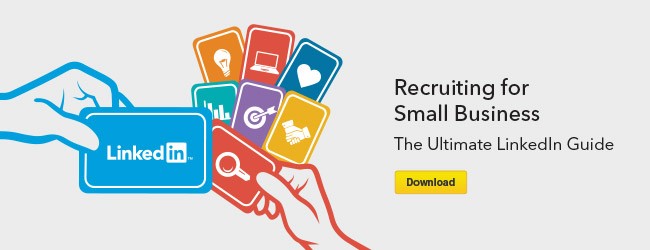Passionate Hiring Managers Help This Small Business Excel in Recruiting
When Tiffany Bloomer, Director of Marketing, Business Development, and Recruiting Lead at Aventis Systems, tells promising candidates they’re going to interview with the company’s CEO, she can practically hear the nervous buzzing in their heads:
“He’s going to grill me, and I’m going to blow it.”
“Is this a test to see if I’ll crack under pressure?”
“Time to pull an all-nighter so I can rehearse.”
To calm candidate nerves, Bloomer and her recruiting colleagues explain that the one-on-one with Hesam Lamei is their opportunity to grill him. “They get to ask any questions they want about Aventis Systems and the job,” Bloomer says. “In fact, our new hires tell us that meeting Hesam often seals the deal and convinces them to join us. The fact that Hesam takes time to do this tells candidates how much we value them.”
Scheduling time with Hesam is just one of the tactics Tiffany’s two person recruiting team uses to maintain its success rate of adding 2-3 new hires a quarter and increasing job applications by 400% in the last year alone.
Here are the tactics Tiffany and team use in order to be successful:
1. Don’t skip the recruiting brief
Marketing and PR teams use creative briefs to outline projects and build alignment, so why not use them for recruiting? For every Aventis Systems open role, Tiffany’s team works closely with the hiring manager to compete a recruiting brief that outlines the need for the new role, the market competing for this talent, and the candidate persona. The result is better communication from the on-set between the recruiter and the hiring manager, and a smoother recruiting process overall.
“After hiring managers complete a brief,” says Tiffany, “it’s clear to see they feel empowered to have played a bigger part in bringing on new people, and appreciate the chance to really define who they want.”
2. Create a recruiting roadmap
You wouldn’t embark on a new business project without a roadmap, and you wouldn’t want to start your candidate search without one either. Tochart a clear path for hiring managers, Bloomer starts all recruiting searches with a roadmap meeting—it can take as little as 10 minutes, but it always makes a big difference.
“In these meetings, we go over writing a strong job description, important interview questions, as well as how to use candidate scoring sheets and the recruiting brief,” Bloomer says. “We also agree upfront to timelines and key dates that will map over to the business unit's need to fill the position and HR's capacity to do so. This is where you get managers fully involved, so they’ll feel a sense of ownership about the hire.”
3. Create full transparency around the addressable market
Recruiters who search for candidates on LinkedIn know that one attribute—like distance from a city center, degree field, or years of experience—can make a huge difference in the talent pool of qualified candidates you discover. And a recruiter’s worst nightmare is limiting potentially great candidates (or opening the flood gates) because these parameters aren’t set up strategically from the get-go.
For full transparency, Bloomer meets with the hiring manager to demonstrate how requiring or excluding certain candidate attributes will affect their addressable talent pool. To do this, she takes requirements for the new hire and runs them through LinkedIn Recruiter, coming up with a list size of possible candidates. “I’ll tell managers that if there are too few candidates, we need to broaden our criteria,” Bloomer says. “Or if there are too many candidates – perhaps a couple thousand – we talk about how to narrow the description and the requirements.”
4. Always know, and drive towards, your KPIs
Key performance indicators, or KPIs,are just as critical to recruiting as to other business teams. And defining, tracking, and reporting those KPIs help my team not only understand and improve their goals over time, but also communicate successes to stakeholders.
The CEO and Tiffany agree to standard KPIs at the beginning of each calendar year to ensure he's satisfied with key metrics that will drive his business forward. And every time an offer letter is created, Bloomer submits standard KPIs directly to the CEO, reporting the goals her team met in order to achieve that hire. The KPIs she has set for her team are:
A) Position Fulfillment & Pipeline Management
- 2 week timeline for thoroughly posting open requisitions
- 100 resume or profile reviews on a monthly basis per requisition
- 20 screenings on a monthly basis per requisition
- 5 face-to-face interviews on a monthly basis per requisition
- 1 face-to-face interview per week minimum for bench/pipeline requisitions
- 60-day position fulfillment
B) Administration
Job Descriptions
- Week timeline for creation or update of documentation
Screening recordings
- 1 submission per screening
Hiring Questionnaires
- 1 week timeline for creation or update of documentation
- 1 submission per screening
Candidate Scoring Sheets
- Weekly updates for all screenings
Offer Letters
- 1 week timeline for creation & approval of documentation
Bonus Compensation Letters
- 1 week timeline for creation & approval of documentation
C) LinkedIn Recruiter Usage
- Job slots (100% maximization)
- Number of searches (performed, saved, alerts)
- Number of profiles (viewed, saved)
- Number of InMails (sent, accepted, declined, response rate)
D) University Partnerships
- Face-to-face meetings with career & counseling centers
- On-campus interviews
- Volunteer activities: resume review, mock interview, LinkedIn 101
E) Reporting
- Weekly recruiting update & candidate scoring sheet to hiring manager
- Weekly recruiting metrics to supervisor
These metrics ensure her team is doing all it can to guarantee the best talent pool and happy hires for Aventis Systems. “Tracking and reporting KPIs show our executives the value of filling positions faster and with better candidates,” Bloomer explains. “It proves why we need tools like LinkedIn Recruiter to stay competitive.”
Tiffany Bloomer grew Aventis Systems from 4 people to nearly 40 today, and she knows that her system for making great hires in less time is not just about processes—it’s about instilling passion in the hiring managers. Every step, from the recruiting brief through the interview with CEO, is designed to help hiring managers see hiring as empowering and exhilarating. Says Bloomer, “When you’re passionate about recruiting, it’s contagious.”
To receive blog posts like this one straight in your inbox, subscribe to the blog newsletter.
Topics: Small business Hiring managers
Related articles




